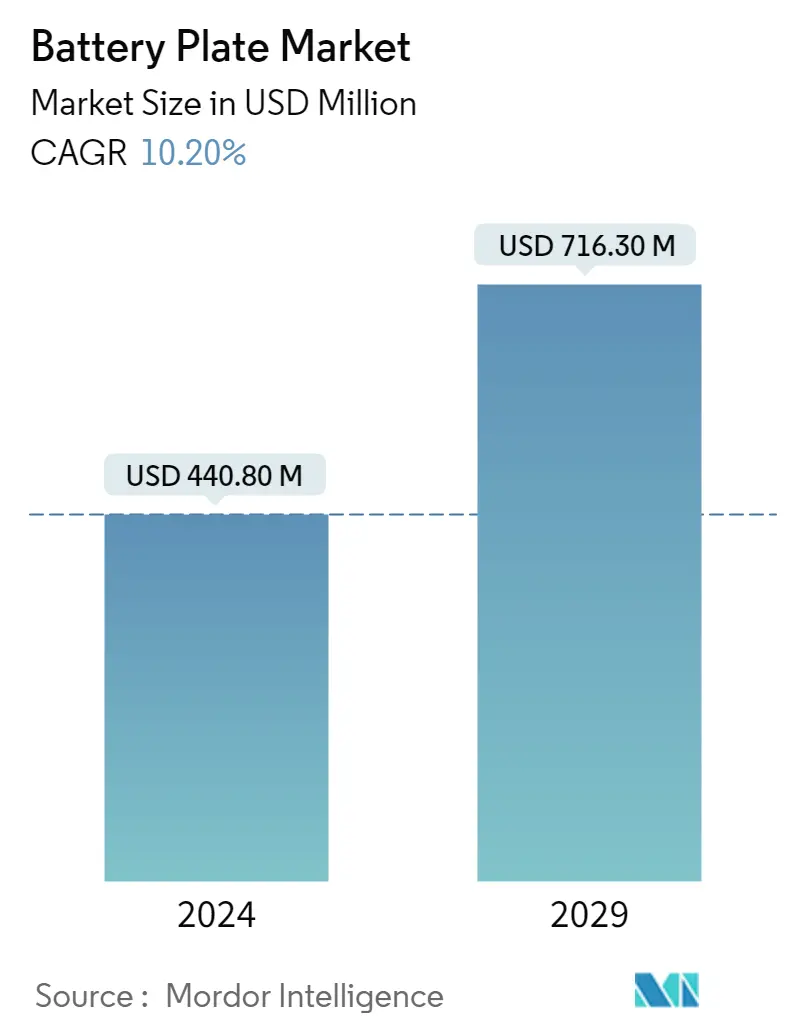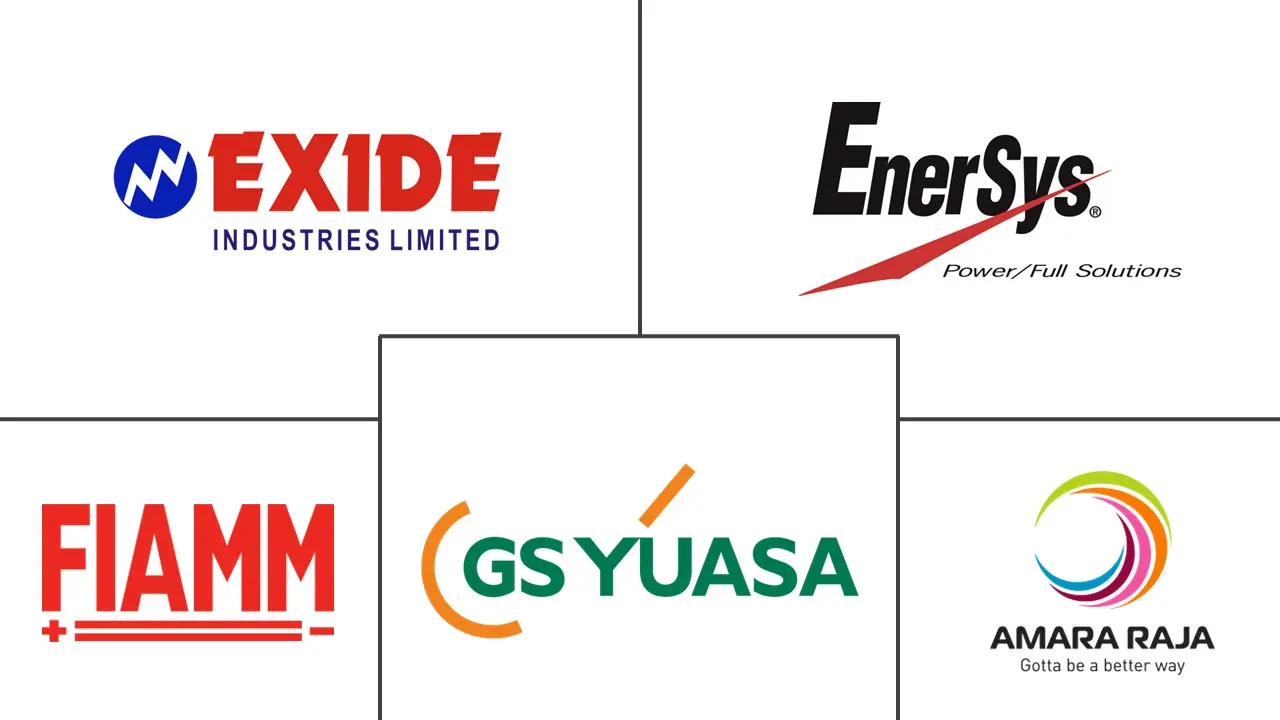Market Size of Battery Plate Industry

| Study Period | 2020 - 2029 |
| Market Size (2024) | USD 440.80 Million |
| Market Size (2029) | USD 716.30 Million |
| CAGR (2024 - 2029) | 10.20 % |
| Fastest Growing Market | Asia Pacific |
| Largest Market | Asia Pacific |
| Market Concentration | Medium |
Major Players
*Disclaimer: Major Players sorted in no particular order |
Battery Plate Market Analysis
The Battery Plate Market size is estimated at USD 440.80 million in 2024, and is expected to reach USD 716.30 million by 2029, growing at a CAGR of 10.20% during the forecast period (2024-2029).
- Over the medium term, factors such as declining prices of lithium-ion batteries and increased penetration of renewable energy driving demand for energy storage systems are likely to drive the battery plate market in the forecast period.
- On the other hand, the demand-supply mismatch of battery raw materials like cobalt, lithium, copper, etc., which is expected to restrain the demand for battery plates in the studied period.
- Nevertheless, technological advancements in novel materials (composites, alloys, etc.) and configurations (bag plates) for battery plates to increase efficiency and sustainability will likely create lucrative growth opportunities for the market during the forecast period.
- Asia-Pacific is the fastest-growing market during the forecast period due to the rising energy demand. This growth is attributed to increasing investments, coupled with supportive government policies in the countries of this region, including India, China, and Australia.
Battery Plate Industry Segmentation
Battery plates are fabricated using a lattice grid structure, supporting the active material within them. Additionally, these plates facilitate the conduction of electricity, allowing for the efficient flow of electrical charges during the charging and discharging processes.
The battery plate market is segmented into battery type, end-user, and geography. By battery type, market is segmented into lithium-ion batteries, lead-acid batteries, and other types. By end-user, the market is segmented into Automotive, Aerospace, Energy Storage, Aerospace, Electronics, and Others. The report also covers the market size and forecasts across major regions. The market sizing and forecasts for each segment are based on revenue (in USD).
Battery Plate Market Size Summary
The battery plate market is poised for significant growth over the forecast period, driven by the declining costs of lithium-ion batteries and the increasing adoption of renewable energy sources. These factors are expected to bolster the demand for energy storage systems, thereby propelling the market forward. However, challenges such as the mismatch in the supply and demand of essential battery raw materials like cobalt, lithium, and copper may pose constraints. Despite these challenges, advancements in novel materials and configurations for battery plates are anticipated to create lucrative opportunities, enhancing efficiency and sustainability. The Asia-Pacific region is projected to be the fastest-growing market, fueled by rising energy demands and supportive government policies in countries like India, China, and Australia.
The electric vehicle (EV) sector has emerged as a dominant force in the battery industry, significantly influencing the demand for lithium-ion batteries. The environmental benefits of EVs, coupled with government incentives and plans to phase out internal combustion engine vehicles, have spurred substantial investments in EV manufacturing and research. This trend is expected to continue, with EVs reaching price parity with traditional vehicles, further driving the demand for battery plates. The Asia-Pacific region, particularly China and India, is witnessing a surge in lithium-ion battery demand due to urbanization and increased power purchase parity. The region's focus on clean energy policies and the establishment of manufacturing facilities under initiatives like India's Production Linked Incentive Scheme are set to bolster the battery plate market, making it a key player in the global landscape.
Battery Plate Market Size - Table of Contents
-
1. MARKET OVERVIEW
-
1.1 Introduction
-
1.2 Market Size and Demand Forecast in USD, till 2028
-
1.3 Recent Trends and Developments
-
1.4 Government Policies and Regulations
-
1.5 Market Dynamics
-
1.5.1 Drivers
-
1.5.1.1 Declining Prices of Lithium-ion Batteries
-
1.5.1.2 Increased Penetration of Energy Storage Systems
-
-
1.5.2 Restraints
-
1.5.2.1 Demand-supply Mismatch of Battery Raw Materials
-
-
-
1.6 Supply Chain Analysis
-
1.7 Porter's Five Forces Analysis
-
1.7.1 Bargaining Power of Suppliers
-
1.7.2 Bargaining Power of Consumers
-
1.7.3 Threat of New Entrants
-
1.7.4 Threat of Substitutes Products and Services
-
1.7.5 Intensity of Competitive Rivalry
-
-
Battery Plate Market Size FAQs
How big is the Battery Plate Market?
The Battery Plate Market size is expected to reach USD 440.80 million in 2024 and grow at a CAGR of 10.20% to reach USD 716.30 million by 2029.
What is the current Battery Plate Market size?
In 2024, the Battery Plate Market size is expected to reach USD 440.80 million.

